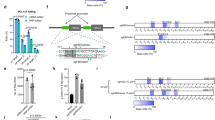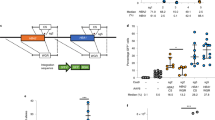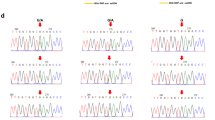Abstract
In humans, mutations in the β-globin gene (HBB) have two important clinical manifestations: β-thalassemia and sickle cell disease. The progress in genome editing and stem cell research may be relevant to the treatment of β-globin-related diseases. In this work, we employed zinc-finger nuclease (ZFN)-mediated gene integration of synthetic β-globin cDNA into HBB loci, thus correcting almost all β-globin mutations. The integration was achieved in both HEK 293 cells and isolated dental pulp stem cell (DPSCs). We also showed that DPSCs with an artificial gene knock-in were capable of generating stable six-cell clones and were expandable at least 108-fold; therefore, they may serve as a personalized stem cell factory. In addition, transfection with non-integrated pCAG-hOct4 and culturing in a conditioned medium converted the genome-edited DPSCs to CD34+ HSC-like cells. We believe that this approach may be useful for the treatment of β-globin-related diseases, especially the severe form of β-thalassemia.
This is a preview of subscription content, access via your institution
Access options
Subscribe to this journal
Receive 12 print issues and online access
$259.00 per year
only $21.58 per issue
Buy this article
- Purchase on Springer Link
- Instant access to full article PDF
Prices may be subject to local taxes which are calculated during checkout




Similar content being viewed by others
References
Higgs DR, Engel JD, Stamatoyannopoulos G . Thalassaemia. Lancet 2012; 379: 373–383.
Bunn HF . Pathogenesis and treatment of sickle cell disease. N Engl J Med 1997; 337: 762–769.
Lucarelli G, Galimberti M, Polchi P, Angelucci E, Baronciani D, Giardini C et al. Bone marrow transplantation in patients with thalassemia. N Engl J Med 1990; 322: 417–421.
Walters MC, Patience M, Leisenring W, Eckman JR, Scott JP, Mentzer WC et al. Bone marrow transplantation for sickle cell disease. N Engl J Med 1996; 335: 369–376.
Sheridan C . Gene therapy finds its niche. Nat Biotechnol 2011; 29: 121–128.
Puthenveetil G, Scholes J, Carbonell D, Qureshi N, Xia P, Zeng L et al. Successful correction of the human b-thalassemia major phenotype using a lentiviral vector. Blood 2004; 104: 3445–3453.
Liu H, Agarwal S, Kmiec E, Davis BR . Targeted beta-globin gene conversion in human hematopoietic CD34(+) and Lin(-)CD38(-)cells. Gene Ther 2002; 9: 118–126.
Romero Z, Urbinati F, Geiger S, Cooper AR, Wherley J, Kaufman ML et al. β-globin gene transfer to human bone marrow for sickle cell disease. J Clin Invest 2013; 123: 3317–3330.
Molete JM, Petrykowska H, Sigg M, Miller W, Hardison R . Functional and binding studies of HS3.2 of the beta-globin locus control region. Gene 2002; 283: 185–197.
Naldini L . Ex vivo gene transfer and correction for cell-based therapies. Nat Rev Genet 2011; 12: 301–315.
Mansilla-Soto J, Riviere I, Boulad F, Sadelain M . Cell and gene therapy for the beta-thalassemias: Advances and prospects. Hum Gene Ther 2016; 27: 295–304.
Negre O, Eggimann AV, Beuzard Y, Ribeil JA, Bourget P, Borwornpinyo S et al. Gene therapy of the β-hemoglobinopathies by lentiviral transfer of the β(A(T87Q))-globin gene. Hum Gene Ther 2016; 27: 148–165.
Cavazzana-Calvo M, Payen E, Negre O, Wang G, Hehir K, Fusil F et al. Transfusion independence and HMGA2 activation after gene therapy of human β-thalassaemia. Nature 2010; 467: 318–322.
Urnov FD, Miller JC, Lee YL, Beausejour CM, Rock JM, Augustus S et al. Highly efficient endogenous human gene correction using designed zinc-finger nucleases. Nature 2005; 435: 646–651.
Li T, Huang S, Jiang WZ, Wright D, Spalding MH, Weeks DP et al. TAL nucleases (TALNs): hybrid proteins composed of TAL effectors and FokI DNA-cleavage domain. Nucleic Acids Res 2011; 39: 359–372.
Cong L, Ran FA, Cox D, Lin S, Barretto R, Habib N et al. Multiplex genome engineering using CRISPR/Cas systems. Science 2013; 339: 819–823.
Wang J, Exline CM, DeClercq JJ, Llewellyn GN, Hayward SB, Li PW et al. Homology-driven genome editing in hematopoietic stem and progenitor cells using ZFN mRNA and AAV6 donors. Nat Biotechnol 2015; 33: 1256–1263.
Moehle EA, Rock JM, Lee YL, Jouvenot Y, DeKelver RC, Gregory PD et al. Targeted gene addition into a specified location in the human genome using designed zinc finger nucleases. Proc Natl Acad Sci USA 2007; 104: 3055–3060.
Zou J, Mali P, Huang X, Dowey SN, Cheng L . Site-specific gene correction of a point mutation in human iPS cells derived from an adult patient with sickle cell disease. Blood 2011; 118: 4599–4608.
Manotham K, Chattong S, Setpakdee A . Generation of CCR5-defective CD34 cells from ZFN-driven stop codon-integrated mesenchymal stem cell clones. J Biomed Sci 2015; 22: 25.
Hanna J, Wernig M, Markoulaki S, Sun CW, Meissner A, Cassady JP et al. Treatment of sickle cell anemia mouse model with iPS cells generated from autologous skin. Science 2007; 318: 1920–1923.
Ma N, Liao B, Zhang H, Wang L, Shan Y, Xue Y et al. Transcription activator-like effector nuclease (TALEN)-mediated gene correction in integration-free β-thalassemia induced pluripotent stem cells. J Biol Chem 2013; 288: 34671–34679.
Xie F, Ye L, Chang JC, Beyer AI, Wang J, Muench MO et al. Seamless gene correction of β-thalassemia mutations in patient-specific iPSCs using CRISPR/Cas9 and piggyBac. Genome Res 2014; 24: 1526–1533.
Huang X, Wang Y, Yan W, Beyer AI, Wang J, Muench MO et al. Production of gene-corrected adult beta globin protein in human erythrocytes differentiated from patient iPSCs after genome editing of the sickle point mutation. Stem Cells 2015; 33: 1470–1479.
Xu P, Tong Y, Liu XZ, Wang TT, Cheng L, Wang BY et al. Both TALENs and CRISPR/Cas9 directly target the HBB IVS2-654 (C > T) mutation in β-thalassemia-derived iPSCs. Sci Rep 2015; 5: 12065.
Song B, Fan Y, He W, Zhu D, Niu X, Wang D et al. Improved hematopoietic differentiation efficiency of gene-corrected beta-thalassemia induced pluripotent stem cells by CRISPR/Cas9 system. Stem Cells Dev 2015; 24: 1053–1065.
Ma N, Shan Y, Liao B, Kong G, Wang C, Huang K et al. Factor-induced reprogramming and zinc finger nuclease-aided gene targeting cause different genome instability in β-thalassemia induced pluripotent stem cells (iPSCs). J Biol Chem 2015; 290: 12079–12089.
Niu X, He W, Song B, Ou Z, Fan D, Chen Y et al. Combining single strand oligodeoxynucleotides and CRISPR/Cas9 to correct gene mutations in β-thalassemia-induced pluripotent stem cells. J Biol Chem 2016; 291: 16576–16585.
Voit RA, Hendel A, Pruett-Miller SM, Porteus MH . Nuclease-mediated gene editing by homologous recombination of the human globin locus. Nucleic Acids Res 2014; 42: 1365–1378.
Pisciotta A, Carnevale G, Meloni S, Riccio M, De Biasi S, Gibellini L et al. Human dental pulp stem cells (hDPSCs): isolation, enrichment and comparative differentiation of two sub-populations. BMC Dev Biol 2015; 15: 14.
Szabo E, Rampalli S, Risueño RM, Schnerch A, Mitchell R, Fiebig-Comyn A et al. Direct conversion of human fibroblasts to multilineage blood progenitors. Nature 2010; 468: 521–526.
Cao A, Galanello R . Beta-thalassemia. Genet Med 2010; 12: 61–76.
Pasi CE, Dereli-Öz A, Negrini S, Friedli M, Fragola G, Lombardo A et al. Genomic instability in induced stem cells. Cell Death Differ 2011; 18: 745–753.
Tsai SQ, Joung JK . What's changed with genome editing? Cell Stem Cell 2014; 15: 3–4.
Hoban MD, Cost GJ, Mendel MC, Romero Z, Kaufman ML, Joglekar AV et al. Correction of the sickle cell disease mutation in human hematopoietic stem/progenitor cells. Blood 2015; 125: 2597–2604.
Ketterer N, Salles G, Raba M, Espinouse D, Sonet A, Tremisi P et al. High CD34(+) cell counts decrease hematologic toxicity of autologous peripheral blood progenitor cell transplantation. Blood 1998; 91: 3148–3155.
Porteus MH . Knock-in editing: it functionally corrects!. Blood 2016; 127: 2507–2509.
Graf T, Enver T . Forcing cells to change lineages. Nature 2009; 462: 587–594.
Vo LT, Daley GQ . De novo generation of HSCs from somatic and pluripotent stem cell sources. Blood 2015; 125: 2641–2648.
Daniel MG, Lemischka IR, Moore K . Converting cell fates: generating hematopoietic stem cells de novo via transcription factor reprogramming. Ann N Y Acad Sci 2016; 1370: 24–35.
Mitchell R, Szabo E, Shapovalova Z, Aslostovar L, Makondo K, Bhatia M . Molecular evidence for OCT4 induced plasticity in adult human fibroblasts required for direct cell fate conversion to lineage specific progenitors. Stem Cells 2014; 32: 2178–2187.
Huang X, Lee MR, Cooper S, Hangoc G, Hong KS, Chung HM et al. Activation of OCT4 enhances ex vivo expansion of human cord blood hematopoietic stem and progenitor cells by regulating HOXB4 expression. Leukemia 2016; 30: 144–153.
Li W, Tian E, Chen ZX, Sun G, Ye P, Yang S et al. Identification of Oct4-activating compounds that enhance reprogramming efficiency. Proc Natl Acad Sci USA 2012; 109: 20853–20858.
Pereira CF, Chang B, Qiu J, Niu X, Papatsenko D, Hendry CE et al. Induction of a hemogenic program in mouse fibroblasts. Cell Stem Cell 2013; 13: 205–218.
Capellera-Garcia S, Pulecio J, Dhulipala K, Siva K, Rayon-Estrada V, Singbrant S et al. Defining the minimal factors required for erythropoiesis through direct lineage conversion. Cell Rep 2016; 15: 2550–2562.
Chang KH, Huang A, Hirata RK, Wang PR, Russell DW, Papayannopoulou T et al. Globin phenotype of erythroid cells derived from human induced pluripotent stem cells. Blood 2010; 115: 2553–2554.
Bottardi S, Aumont A, Grosveld F, Milot E . Developmental stage-specific epigenetic control of human beta-globin gene expression is potentiated in hematopoietic progenitor cells prior to their transcriptional activation. Blood 2003; 102: 3989–3997.
Chattong S, Rungsiwiwut R, Yindeedej W, Sereemaspun A, Pruksananonda, Virutamasen P et al. Human dental pulp stem cells as a potential feeder layer for human embryonic stem cell culture. Asian Biomedicine 2014; 8: 333–343.
Manotham K, Tanaka T, Matsumoto M, Ohse T, Miyata T, Inagi R et al. Evidence of tubular hypoxia in the early phase in the remnant kidney model. J Am Soc Nephrol 2004; 15: 1277–1288.
Klock HE, Lesley SA . The polymerase incomplete primer extension (PIPE) method applied to high-throughput cloning and site-directed mutagenesis. Methods Mol Biol 2009; 498: 91–103.
Acknowledgements
We thank Prof. Reiko Inagi (University of Tokyo, Tokyo) and Prof. Kanya Suphapeetiporn (Chulalongkorn Universty, Bangkok) for their helpful advice. We are grateful to Dr. Ryoji Sassa (Okasaki, Nagoya) for his generous support. This work was supported Lerdsin Foundation and SS Manufacturing.
Author contributions
SC: Conception and design, Collection and/or assembly of data, Data analysis and interpretation, Manuscript writing. OR: Conception and design, Collection and/or assembly of data, Data analysis and interpretation Financial support. WY: Provision of study material or patients. AS: Financial support, Administrative support. KM: Conception and design, Collection and/or assembly of data, Data analysis and interpretation, Manuscript writing, Administrative support Final approval of manuscript.
Author information
Authors and Affiliations
Corresponding author
Ethics declarations
Competing interests
SC receives compensation as a consultant for SS Manufacturing Co., Ltd. OR is a share holder of SS Manufacturing Co., Ltd. The remaining authors declare no conflict of interest.
Rights and permissions
About this article
Cite this article
Chattong, S., Ruangwattanasuk, O., Yindeedej, W. et al. CD34+ cells from dental pulp stem cells with a ZFN-mediated and homology-driven repair-mediated locus-specific knock-in of an artificial β-globin gene. Gene Ther 24, 425–432 (2017). https://doi.org/10.1038/gt.2017.42
Received:
Revised:
Accepted:
Published:
Issue Date:
DOI: https://doi.org/10.1038/gt.2017.42
This article is cited by
-
Re-educating immunity in respiratory allergies: the potential for hematopoietic stem cell-mediated gene therapy
Journal of Molecular Medicine (2018)



